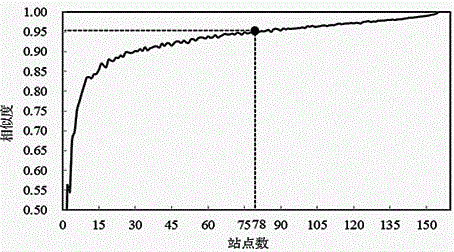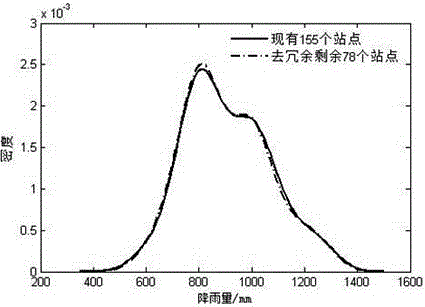Basin rainfall monitoring wireless sensor network node optimization layout method
A wireless sensor and precipitation monitoring technology, applied in wireless communication, network topology, network planning, etc., can solve problems such as time-consuming, difficult to capture regional precipitation distribution, approximate true value error, etc.
- Summary
- Abstract
- Description
- Claims
- Application Information
AI Technical Summary
Problems solved by technology
Method used
Image
Examples
Embodiment 1
[0056] This embodiment is a method for optimizing the layout of wireless sensor network nodes for watershed precipitation monitoring. The method improves the traditional method of station extraction, and analyzes the density of the existing station network based on the improved station extraction method, removes redundant stations, and directly considers the restrictions on the feasibility of station deployment by the road network on this basis. Adding station alternative areas, adding stations in the alternative areas in turn, comprehensively using the correlation between the target variable precipitation and environmental variables such as latitude, longitude, elevation, slope, and aspect, to establish the site layout with regression Kriging variance as the objective function Optimization model, based on the parallel designed simulated annealing algorithm, through high-performance solution of the site layout optimization model, to achieve the optimized layout of precipitation ...
Embodiment 2
[0181] This embodiment is an improvement of the first embodiment, and is a refinement of the calculation of the correlation in the "steps of correlation calculation" in the first embodiment. The calculation of correlation in the "steps of correlation calculation" described in this embodiment includes the following sub-steps:
[0182] Calculate the annual average precipitation at each station according to the precipitation data obtained by the existing stations.
[0183] Obtain the slope and aspect data of the research area according to the DEM data of the research area where the existing site is located;
[0184] Extract the elevation, slope and aspect of the existing site according to the latitude and longitude information of the existing site;
[0185] Perform correlation analysis based on the annual average precipitation data and environmental variable data at the existing stations, and calculate the correlation coefficient and significance level between the target variable and the...
Embodiment 3
[0192] This embodiment is an improvement of the above embodiment, and is a refinement of the regression analysis described in the “steps of regression analysis” in the above embodiment. The regression analysis described in the "steps of regression analysis" described in this embodiment includes the following sub-steps:
[0193] According to the correlation coefficient and significance level between the target variable and the environmental variable, select the environmental variable that is significantly related to the average annual precipitation, namely the correlation coefficient p For environmental variables <0.05, generalized least square regression analysis is performed with the annual average precipitation to calculate the regression coefficient.
[0194] According to the generalized least squares regression coefficient, calculate the regression residual of precipitation at the existing station, and use GS+ software to calculate the variance function of the regression residua...
PUM
 Login to View More
Login to View More Abstract
Description
Claims
Application Information
 Login to View More
Login to View More - R&D
- Intellectual Property
- Life Sciences
- Materials
- Tech Scout
- Unparalleled Data Quality
- Higher Quality Content
- 60% Fewer Hallucinations
Browse by: Latest US Patents, China's latest patents, Technical Efficacy Thesaurus, Application Domain, Technology Topic, Popular Technical Reports.
© 2025 PatSnap. All rights reserved.Legal|Privacy policy|Modern Slavery Act Transparency Statement|Sitemap|About US| Contact US: help@patsnap.com



